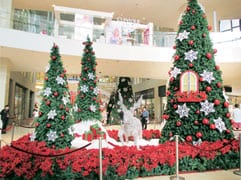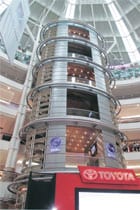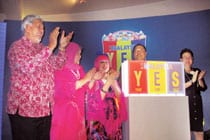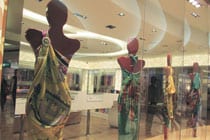Mega Malaysia
From high fashion designer wear in luxury malls to traditional handicrafts in a street bazaar, the 1Malaysia Year End Sale is a great opportunity for visitors to Malaysia to get products at the best prices, along with simultaneously enjoying the unique culture, cuisine and the many attractions of the country By Sudipta Dev
 The 1Malaysia Year-End Sale (1MYES) got off to a stupendous start in Malayasia on November 15, 2014, coinciding with the Mega Fam programme which saw participation from 277 media and travel industry delegates from 26 countries. The annual year end sale reaffirmed Malaysia’s position as one of the world’s leading shopping destinations that has a great attraction for visitors from all over the world. Malaysia organises three major sale campaigns every year – the 1Malaysia Grand Prix Sale in March, the 1Malaysia Mega Sale Carnival from June to September, and 1MYES from November 15, 2014 to January 4, 2015. These grand sale events give an opportunity to foreign tourists to buy the best of products ranging from ethnic handicrafts to the biggest international brands at value for money deals in the many cities across the country, along with exploring Malaysia’s attractions as a tourism destination.
The 1Malaysia Year-End Sale (1MYES) got off to a stupendous start in Malayasia on November 15, 2014, coinciding with the Mega Fam programme which saw participation from 277 media and travel industry delegates from 26 countries. The annual year end sale reaffirmed Malaysia’s position as one of the world’s leading shopping destinations that has a great attraction for visitors from all over the world. Malaysia organises three major sale campaigns every year – the 1Malaysia Grand Prix Sale in March, the 1Malaysia Mega Sale Carnival from June to September, and 1MYES from November 15, 2014 to January 4, 2015. These grand sale events give an opportunity to foreign tourists to buy the best of products ranging from ethnic handicrafts to the biggest international brands at value for money deals in the many cities across the country, along with exploring Malaysia’s attractions as a tourism destination.
Launching 1MYES 2014 at the National Visual Arts Gallery in Kuala Lumpur, Dato’ Maznah Mazlan, deputy chairman, Tourism Malaysia, said, “Kuala Lumpur has been acknowledged as the second best destination for shopping in APAC by Globe Shopper Index. Malaysia’s shopping experience is something for you to remember. The retail industry plays a very important part in supporting and making the event a success. The collective effort is the combined ability to offer low prices in most of the shops, including three of the biggest shopping malls in Asia, which makes Malaysia the world’s premier shopping destination.”
The focus on high fashion is a part of Malaysia’s effort to become a haven for luxury goods. “The country is already a duty free haven for most luxury goods including watches and jewellery,” said Mazlan. Shopping is a significant contributor to the nation’s tourism industry, and the second biggest share of tourist expenditure after accommodation. The retail sector constituted 30.2 per cent of the total tourist expenditure in 2013. Tourist expenditure on shopping was RM 19.8 billion. The 1MYES is a prelude to an exciting new campaign. In 2015, it is going to be a year of endless celebrations in Malaysia with the launch of the Malaysia Year of Festivals (MyFEST).
Strategic tourism
Tourism in Malaysia started in 1959. The international network today includes 37 overseas offices and seven marketing offices. The New Delhi office was set up in 2000 and that in Mumbai a year later. Today India is at number six position among the top tourist generating markets. The domestic tourism market is also an important segment, with a network comprising 13 offices. “Our objective includes increasing foreign tourist arrivals, extending the average length of stay and increasing the market share of international MICE segment,” said Dato’ Hj Azizan Noordin, deputy director general (Promotion), Tourism Malaysia. The year 2013 saw 25.7 million tourists, with receipts worth RM 65.4 billion. The forecast for 2014 is 28 million tourist arrivals (RM 75 billion).
The target market ranges from leisure to eco tourism, education tourism, sports tourism, incentive, shopping, homestay and others. As far as India is concerned the focus segments are – leisure high end travel, shopping, honeymooners, education tourism and incentive travel. “We get a lot of weddings from the India market,” informed Noordin.
Malaysia has been organising Mega Fam programmes since 2000, and since then Tourism Malaysia has hosted 45,000 participants. The Mega Fam participants enjoyed a tour of Kuala Lumpur’s Shopping Trail – the Bukit Bintang-KLCC (BBKLCC) Walk.
Focus Kuala Lumpur
 There are three key aspects in Kuala Lumpur that would attract a visitor, acknowledged Noraza Yusof, head of tourism, Kuala Lumpur City Hall. These are – shopping, food and culture. There are plans introduce a shopping bus by March 2015 to connect the hotels to the malls. “Kuala Lumpur is a duty free fashion paradise, which is propelled by luxury fashion. There is duty free shopping, excellent price point, etc.,” said Yusof. She pointed out that Kuala Lumpur has become a fashionable city with a few designers having made it big globally. “There are also home grown designers and stores. About 20 minutes drive from Kuala Lumpur is the MO Outlet which has 50 brands selling products that are just a season behind,” she added.
There are three key aspects in Kuala Lumpur that would attract a visitor, acknowledged Noraza Yusof, head of tourism, Kuala Lumpur City Hall. These are – shopping, food and culture. There are plans introduce a shopping bus by March 2015 to connect the hotels to the malls. “Kuala Lumpur is a duty free fashion paradise, which is propelled by luxury fashion. There is duty free shopping, excellent price point, etc.,” said Yusof. She pointed out that Kuala Lumpur has become a fashionable city with a few designers having made it big globally. “There are also home grown designers and stores. About 20 minutes drive from Kuala Lumpur is the MO Outlet which has 50 brands selling products that are just a season behind,” she added.
Being a true melting point of Malaysia, not surprisingly Kuala Lumpur is also a food heaven. At WTM recently, the Kuala Lumpur Food Trails guide was launched ranging from the best of Indian food in Brickfields to the local Peranakan cuisine available in quaint restaurants across the city. There are many unexplored attractions for repeat visitors to the city as well, for instance the free ‘Jalan-Jalan@Kampung Bharu’ guided walk to explore Malay culture in a traditional village. Kuala Lumpur is also fast emerging as a city of shows, performances and culture, for instance the musical production – Mud: Our Story of Kuala Lumpur at the historic Panggung Bandaraya and the just launched License to Thrill – A Bond Concert at the majestic Istana Budaya. There is also the Petronas Filharmonik Hall, home to the Malaysian Philharmonic Orchestra. Kuala Lumpur is also a MICE city of distinction in APAC region.
Shopper’s paradise
 The history of malls in Malaysia began in 1973. The country has many big shopping complexes, and more than 350 shopping malls. Of the top 10 largest shopping malls in the world, three are in Malaysia. These are the Egyptian themed Sunway Pyramid, Mid Valley Megamall, and 1Utama Shopping Centre. In the global future supply of malls, Malaysia ranks in the number nine position. The future mall projects coming up include Sunway Velocity Mall and Sunway Putra Mall in Kuala Lumpur.
The history of malls in Malaysia began in 1973. The country has many big shopping complexes, and more than 350 shopping malls. Of the top 10 largest shopping malls in the world, three are in Malaysia. These are the Egyptian themed Sunway Pyramid, Mid Valley Megamall, and 1Utama Shopping Centre. In the global future supply of malls, Malaysia ranks in the number nine position. The future mall projects coming up include Sunway Velocity Mall and Sunway Putra Mall in Kuala Lumpur.
BBKLCC in Kuala Lumpur has 3000 stores across nine malls – Pavilion Kuala Lumpur, Fahrenheit88, Lot 10, BB Plaza, Suria KLCC, Berjaya Times Square, Sungei Wang Palza, Plaza Low Yat and Starhill Gallery. From bargain shopping at Sungie Wang to exclusive stores in Suria KLCC at the iconic Petronas Twin Towers, tourists can get great discounts at hundreds of stores.
Having been declared a duty free shopping destination since 2011, visitors can get a wide range of tax exempted goods at Malaysia’s many popular duty-free zones, which includes the islands of Langkawi, Labuan and Tioman.
 Johor Premium Outlets is the first in Southeast Asia and features more than a 100 designers and brand outlet stores offering savings of almost 65 per cent. The other important shopping venues in Johor are Johor Bahru City Square, Galleria@Kotaraya and the Zon Shopping Mall. In Melaka, the Dataran Pahlawan Megamall takes the centre-stage in branded shopping, while the Jonker Street offers a treasure trove of artefacts for the discerning traveller.
Johor Premium Outlets is the first in Southeast Asia and features more than a 100 designers and brand outlet stores offering savings of almost 65 per cent. The other important shopping venues in Johor are Johor Bahru City Square, Galleria@Kotaraya and the Zon Shopping Mall. In Melaka, the Dataran Pahlawan Megamall takes the centre-stage in branded shopping, while the Jonker Street offers a treasure trove of artefacts for the discerning traveller.
The shopping experience in Penang is not limited to its many malls – the city is famous for its mile long night market, which is a great draw for tourists – from clothes to handicrafts to computer games there are many interesting bargains at the Batu Feringghi Sidewalk Bazaar. Well known for its natural beauty Sabah is also famous for its handicrafts, which visitors can purchase from Wawasan Plaza in Kota Kinabalu and the Handicraft Market at Jalan Tun Fuad Stephens. 1Borneo Hypermall Autocity and Suria Sabah are the better known malls in Sabah. While mall enthusiasts in Sarawak can go to the Boulevard Shopping Complex in Miri or The Crowne Plaza Shopping Complex in Kuching city, to get the essence of the land, its culture and people, a visit to the many quaint sidewalk stores is a must.

